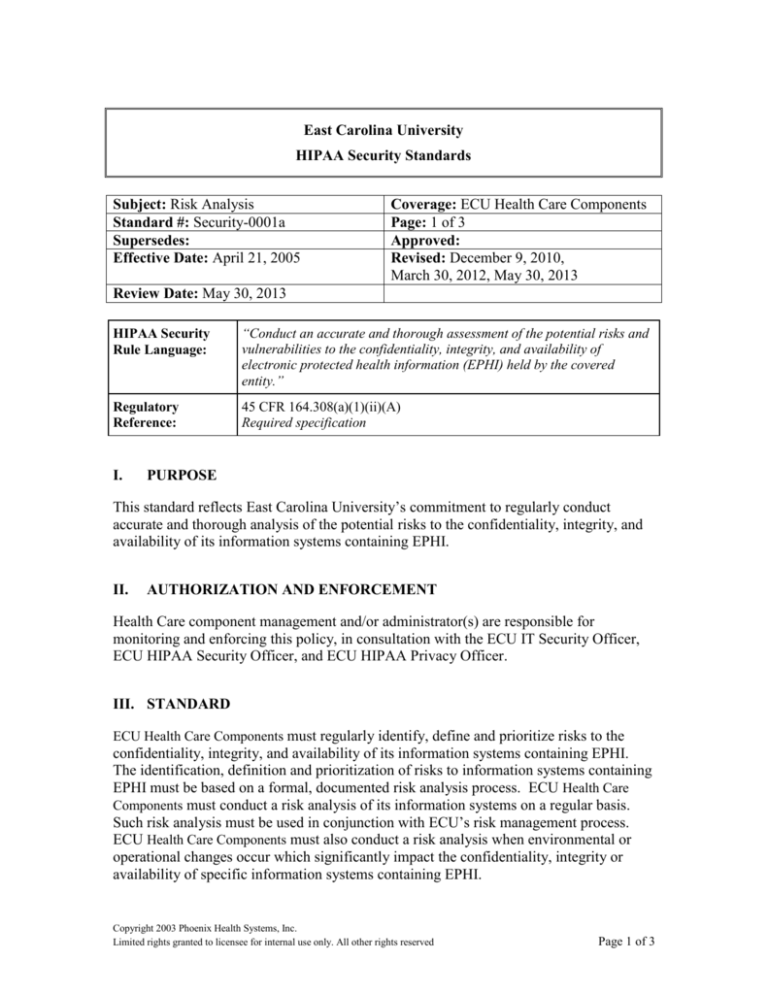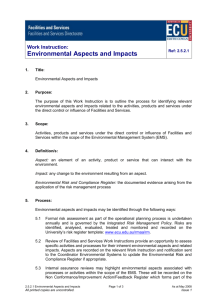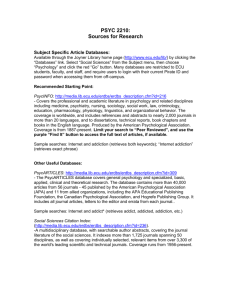
East Carolina University
HIPAA Security Standards
Subject: Risk Analysis
Standard #: Security-0001a
Supersedes:
Effective Date: April 21, 2005
Coverage: ECU Health Care Components
Page: 1 of 3
Approved:
Revised: December 9, 2010,
March 30, 2012, May 30, 2013
Review Date: May 30, 2013
HIPAA Security
Rule Language:
“Conduct an accurate and thorough assessment of the potential risks and
vulnerabilities to the confidentiality, integrity, and availability of
electronic protected health information (EPHI) held by the covered
entity.”
Regulatory
Reference:
45 CFR 164.308(a)(1)(ii)(A)
Required specification
I.
PURPOSE
This standard reflects East Carolina University’s commitment to regularly conduct
accurate and thorough analysis of the potential risks to the confidentiality, integrity, and
availability of its information systems containing EPHI.
II.
AUTHORIZATION AND ENFORCEMENT
Health Care component management and/or administrator(s) are responsible for
monitoring and enforcing this policy, in consultation with the ECU IT Security Officer,
ECU HIPAA Security Officer, and ECU HIPAA Privacy Officer.
III. STANDARD
ECU Health Care Components must regularly identify, define and prioritize risks to the
confidentiality, integrity, and availability of its information systems containing EPHI.
The identification, definition and prioritization of risks to information systems containing
EPHI must be based on a formal, documented risk analysis process. ECU Health Care
Components must conduct a risk analysis of its information systems on a regular basis.
Such risk analysis must be used in conjunction with ECU’s risk management process.
ECU Health Care Components must also conduct a risk analysis when environmental or
operational changes occur which significantly impact the confidentiality, integrity or
availability of specific information systems containing EPHI.
Copyright 2003 Phoenix Health Systems, Inc.
Limited rights granted to licensee for internal use only. All other rights reserved
Page 1 of 3
HIPAA Security Standard # 0001a: Risk Analysis
IV. APPLICABILITY
This standard is applicable to all workforce members who are responsible for or
otherwise administer a healthcare computing system. A healthcare computing system is
defined as a device or group of devices that store EPHI which is shared across the
network and accessed by healthcare workers.
V.
PROCEDURE
1. ECU Health Care Components must regularly identify, define and prioritize risks to
the confidentiality, integrity, and availability of its information systems containing
EPHI.
2. The identification, definition and prioritization of risks to information systems
containing EPHI must be based on a formal, documented risk analysis process. At a
minimum, ECU Health Care Components’ risk analysis process must include the
following:
Identification and prioritization of the threats to information systems containing
EPHI.
b. Identification and prioritization of the vulnerabilities of information systems
containing EPHI.
c. Identification and definition of security measures used to protect the
confidentiality, integrity, and availability of information systems containing
EPHI.
d. Identification of the likelihood that a given threat will exploit a specific
vulnerability on an ECU information system containing EPHI.
e. Identification of the potential impacts to the confidentiality, integrity, and
availability of information systems containing EPHI if a given threat exploits a
specific vulnerability.
a.
3. ECU Health Care Components must conduct risk analysis on a regular basis. Such
risk analysis must be used in conjunction with ECU’s risk management process to
identify, select and implement security measures to protect the confidentiality,
integrity, and availability of information systems containing EPHI.
4. Judgments used in ECU Health Care Components’ risk analysis, such as assumptions,
defaults, and uncertainties, should be explicitly stated and documented.
5. In addition to regular risk analysis, ECU Health Care Components must conduct a
risk analysis when environmental or operational changes occur which significantly
impact the confidentiality, integrity or availability of specific information systems
containing EPHI. Such changes include but are not limited to:
a. Significant security incidents to specific information systems containing EPHI.
b. Significant new threats or risks to specific information systems containing EPHI.
Copyright 2003 Phoenix Health Systems, Inc.
Limited rights granted to licensee for internal use only. All other rights reserved
Page 2 of 3
HIPAA Security Standard # 0001a: Risk Analysis
c. Significant changes to the organizational or technical infrastructure of ECU which
affect specific information systems containing EPHI.
d. Significant changes to ECU information security requirements or responsibilities
which affect specific information systems containing EPHI.
6. ECU’s risk analysis process must be based on the following steps, which shall be
formally documented and securely maintained:
a.
b.
c.
d.
e.
f.
g.
Inventory. ECU Health Care Components must conduct a regular inventory of
its information systems containing EPHI and the security measures protecting
those systems.
Threat identification. ECU Health Care Components must identify all potential
threats to its information systems containing EPHI. Such threats may be natural,
human or environmental.
Vulnerability identification. ECU Health Care Components must identify all
vulnerabilities on its information systems containing EPHI. This should be done
by regularly reviewing vulnerability sources and performing security assessments.
Security control analysis. ECU Health Care Components must analyze the
security measures that have been implemented or will be implemented to protect
its information systems containing EPHI; this includes both preventive and
detective controls.
Risk likelihood determination. ECU Health Care Components must assign a
rating to each specific risk which indicates the probability that a vulnerability will
be exploited by a particular threat. Three factors should be considered: 1) threat
motivation and capability, 2) type of vulnerability, and 3) existence and
effectiveness of current security controls
Impact analysis. ECU Health Care Components must determine the impact to
confidentiality, integrity or availability of EPHI which would result if a threat
were to successfully exploit a vulnerability on an ECU information system
containing EPHI.
Risk Determination. ECU Health Care Components must use the information
obtained in the above six steps to identify the level of risk to specific information
systems containing EPHI. For each vulnerability and associated possible threat,
ECU Health Care Components must make a risk determination based on:
The likelihood a certain threat will attempt to exploit a specific vulnerability.
The level of impact should the threat successfully exploit the vulnerability.
The adequacy of planned or existing security controls.
VI. COORDINATING INSTRUCTIONS
1. All section policies and procedures will be reviewed annually. Every section policy
and procedure revision/replacement will be maintained for a minimum of six years
from the date of its creation or when it was last in effect, whichever is later. Other
East Carolina University, University of North Carolina system, or state of North
Carolina requirements may stipulate a longer retention.
Copyright 2003 Phoenix Health Systems, Inc.
Limited rights granted to licensee for internal use only. All other rights reserved
Page 3 of 3








